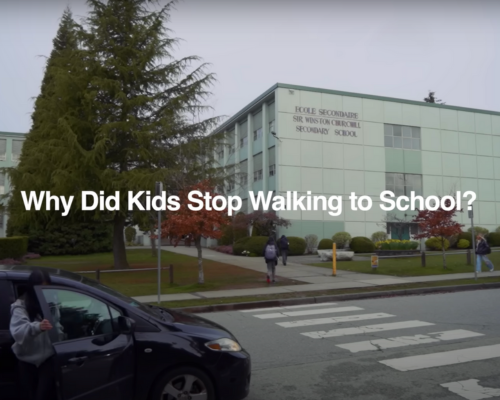 While the video below is from Vancouver, British Columbia, “The Why” that it outlines and the supporting data it shares for why kids stopped walking or riding to school resonates and feels very plausible for us–and are some of the exact data points BFC is dedicated to changing. It’s a 12-minute video that is worth the watch, but if you don’t have the time, here are the highlights:
While the video below is from Vancouver, British Columbia, “The Why” that it outlines and the supporting data it shares for why kids stopped walking or riding to school resonates and feels very plausible for us–and are some of the exact data points BFC is dedicated to changing. It’s a 12-minute video that is worth the watch, but if you don’t have the time, here are the highlights:
- The number of children walking or biking to school (in the U.S.) dropped from 48% in 1969 to just 11% in 2021. (That said, Fort Collins is currently at about 23%, on our way to our goal of 50+%).
- Today, over 50% of students (4th and 7th graders) are driven to school in a car by a parent.
- Research has shown that not participating in active transportation to get to school is negatively impacting students’ health, academics, and independence.
- This trend is impacting everyone, even for those who don’t have kids or kids in school, with increased congestion, pollution, and poor air quality (school drop-offs represent 20% of traffic in the morning commute).
- Some people point to suburban sprawl as the culprit, with the number of kids (in the U.S.) living within 1-mile of their school who walk or ride to school dropping from nearly 35% in 1969 to just under 20% by 2000.
- Only 47% of Canadian students who live within a 5 minute walk/ride to their school do so.
So what’s behind this trend? Many of the reasons are some of the same types of things you’ll find or have seen BFC advocating for, like a better bicycle network and safer routes to school, and bicycle equity, etc.:
- Students who walk or bike to school are respectively 4.5-times and 22-times more likely to be injured when walking or bicycling to school, largely due to vehicular conflict.
- The video compares the above statistic to The Netherlands, who have prioritized facility and network design for bikes and peds (something we have been supportive of in influencing our network and facility design), and have seen fatality rates drop to nearly zero for ALL modes of transporation.
- North America is amidst a circular reference: As more and more students are driven to school, it equates to more vehicles on the road subsequently making the roads less safe to walk and cycle, which only makes more parents more likely to drive their student(s) to school.
- A comprehensive study showed that, since the 1970s, kids have been losing their independence, with parents simply not allowing children to do things unsupervised (like walking or biking to school).
- Couple this trend with the proliferation of dual-income/working families since the 70s, getting to school now often has to comport with parent work schedules, which often means driving them to school.
- Unsettlingly though, not all parents can afford a car, and/or some single parent families don’t have the flexibility to drive their student(s) to school. So, the students HAVE to walk or ride. A study found the children of low income parents are 2 to 3-times more likely to walk or ride to school.
- Unfortunately, this is compounded with low income areas of the community often being some of the most deficient of sidewalks and bicycle infrastructure, highlighting what an equity issue it is.
So how does the video suggest we fix this? Encouragingly Fort Collins (and BFC) are already doing some of these, or have them on our radar:
- Certainly continuing to improve infrastructure, and the safety of the pedestrian and bicycle network is a need.
- But, the video suggests that it’s as much a cultural issue as it is an infrastructure issue.
- Can employers adopt more flexible work schedules for parents? A Toronto study found that flexible work hours could play a bigger role in the mode choice parents and children elect to get to school.
- We should address low hanging fruit in terms of safety improvements to infrastructure near schools, such as crosswalks, to increase parent confidence in allowing students to walk or ride.
- We should introduce programs that encourage a culture of active transportation among students, like cycling classes in public schools (which the City of Fort Collins and BFC already do with our Safe Routes to School (SRTS) program).
- The video also mentions:
- Establishing “Walking or Biking School Buses” led by adults or older students.
- Implementing “School Streets,” which close down streets in front of schools during drop-off and pick-up times (an initiative we support and know our city is working to pilot test).
- Starting “Drive to Five” programs, which encourage and ask parents to drop their kids off in locations that are a 5-minute walk to school. This reduces vehicle congestion around the school while developing an active transportation mindset for the student. It should be noted that this is something we already do and encourage during our October Walk/Bike-to-School Challenge that our SRTS program hosts with PSD. A student who is dropped-off a 5-minute walk away from school can count that as a day walked for the Challenge.
Source: www.youtube.com/c/AboutHere
